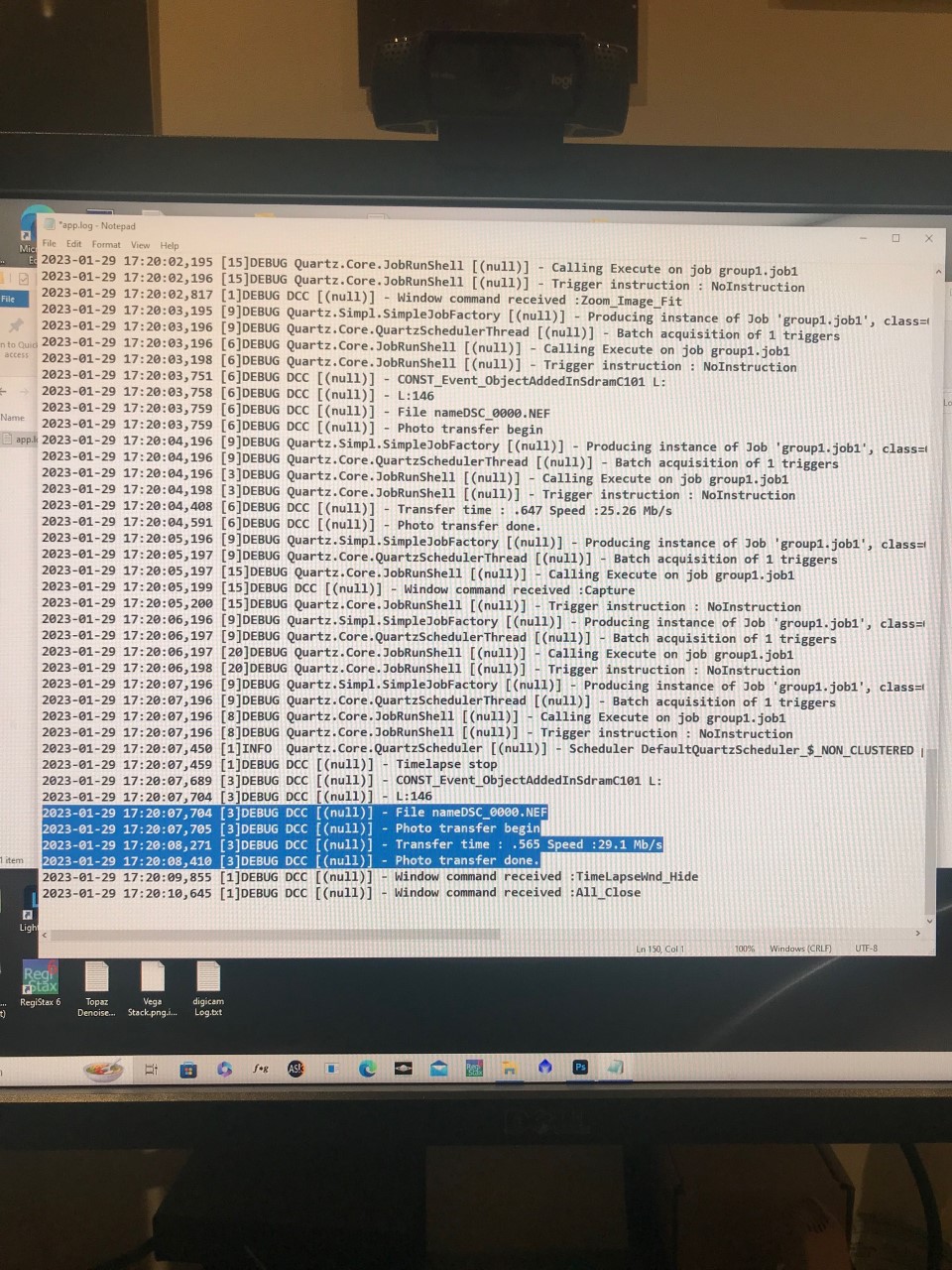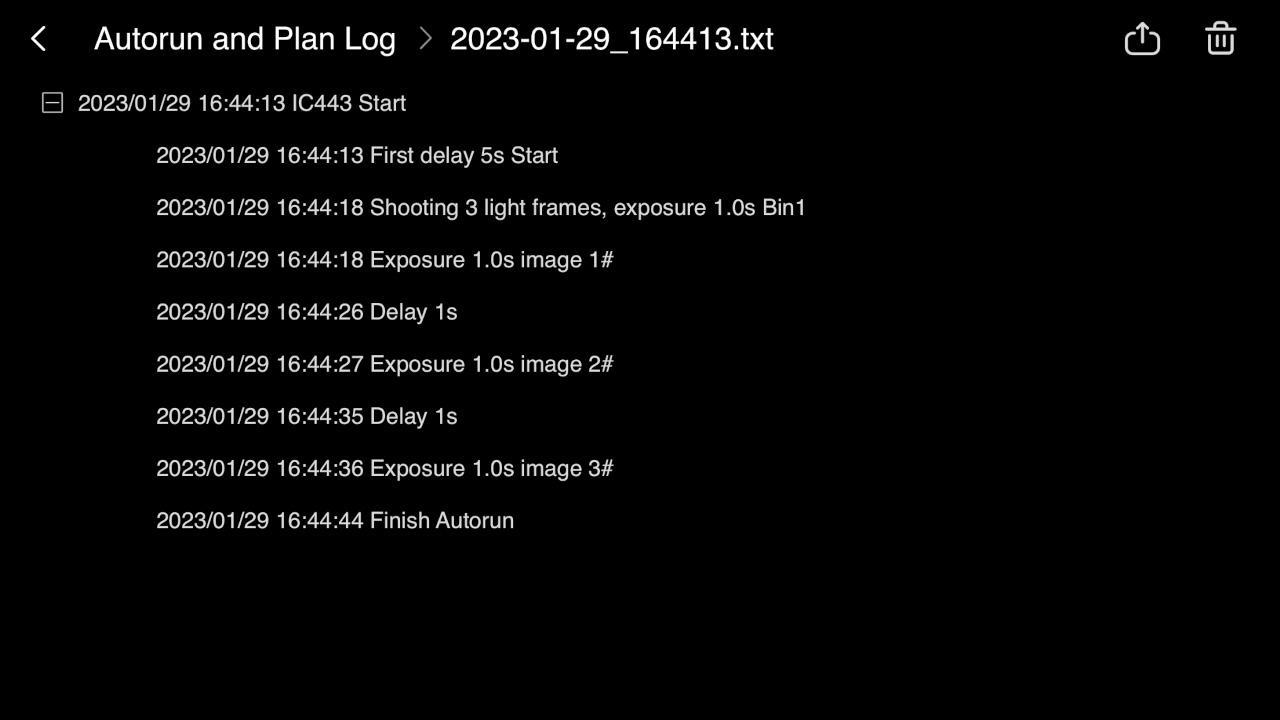Hi All,
I'm wondering whether it might be possible to compare notes with you on a specific aspect of astrophotography?
I use a relatively low-powered laptop to operate my kit. For some time I've been feeling that it isn't really powerful enough to do the job well. But I've been finding it difficult to get to a firm conclusion. I'm thinking about maybe upgrading to a more powerful machine, but am unsure what benefits I would see if I did so, and how powerful a machine would be the best bet.
I'm rather lacking in knowledge of how other people's kit performs. I've come up with a way of comparing notes using specific data. Would you be willing to collaborate in a survey, from which useful information could hopefully be collated and then shared with the group?
I'd like to compare measurements of the time intervals between frames when shooting a sequence. How many seconds elapse between one exposure completing and the next one starting? I think my setup might be rather slow, and that yours might be faster. But it would be good to have some figures to compare.
For information my system consists of a Windows 10 laptop with an i3 processor. My camera is a Canon DSLR and I am using the software package "Backyard EOS" to operate it. The following listing shows details for a few frames out of a set - giving file names and date/time info as recorded in the file tags.
dither
D1827.0011 B01 Elephant (600mm f8.1 iso800 480sec) 05/10/2022 21:55:13
D1827.0012 B01 Elephant (600mm f8.1 iso800 480sec) 05/10/2022 22:03:47
dither
D1827.0013 B01 Elephant (600mm f8.1 iso800 480sec) 05/10/2022 22:12:59
D1827.0014 B01 Elephant (600mm f8.1 iso800 480sec) 05/10/2022 22:21:33
dither
D1827.0015 B01 Elephant (600mm f8.1 iso800 480sec) 05/10/2022 22:30:48
D1827.0016 B01 Elephant (600mm f8.1 iso800 480sec) 05/10/2022 22:39:23
dither
D1827.0017 B01 Elephant (600mm f8.1 iso800 480sec) 05/10/2022 22:48:45
With this dataset I was dithering every second frame. The exposure time was 480 seconds (8 minutes). If you look at the time difference between each of the pairs of "between dither" frames, they all work out to roughly 8 minutes and 35 seconds. I know that by switching off the downloading of images to the laptop and just saving them on the camera's memory card, the time difference will come down to about 8 minutes and 25 seconds. So of the 35 seconds between frames, roughly 10 seconds appears to be downloading time. The other 25 seconds is taken up with assorted stuff that the software seems to need to do before it is ready to ask the camera to start the next exposure.
I wonder how the figures compare with those from your system? Would you be willing to share any information? Solid data if possible, together with an outline spec of your hardware and software.
I'll be extremely grateful for any feedback that you might be prepared to offer!
Regards,
Tim
I'm wondering whether it might be possible to compare notes with you on a specific aspect of astrophotography?
I use a relatively low-powered laptop to operate my kit. For some time I've been feeling that it isn't really powerful enough to do the job well. But I've been finding it difficult to get to a firm conclusion. I'm thinking about maybe upgrading to a more powerful machine, but am unsure what benefits I would see if I did so, and how powerful a machine would be the best bet.
I'm rather lacking in knowledge of how other people's kit performs. I've come up with a way of comparing notes using specific data. Would you be willing to collaborate in a survey, from which useful information could hopefully be collated and then shared with the group?
I'd like to compare measurements of the time intervals between frames when shooting a sequence. How many seconds elapse between one exposure completing and the next one starting? I think my setup might be rather slow, and that yours might be faster. But it would be good to have some figures to compare.
For information my system consists of a Windows 10 laptop with an i3 processor. My camera is a Canon DSLR and I am using the software package "Backyard EOS" to operate it. The following listing shows details for a few frames out of a set - giving file names and date/time info as recorded in the file tags.
dither
D1827.0011 B01 Elephant (600mm f8.1 iso800 480sec) 05/10/2022 21:55:13
D1827.0012 B01 Elephant (600mm f8.1 iso800 480sec) 05/10/2022 22:03:47
dither
D1827.0013 B01 Elephant (600mm f8.1 iso800 480sec) 05/10/2022 22:12:59
D1827.0014 B01 Elephant (600mm f8.1 iso800 480sec) 05/10/2022 22:21:33
dither
D1827.0015 B01 Elephant (600mm f8.1 iso800 480sec) 05/10/2022 22:30:48
D1827.0016 B01 Elephant (600mm f8.1 iso800 480sec) 05/10/2022 22:39:23
dither
D1827.0017 B01 Elephant (600mm f8.1 iso800 480sec) 05/10/2022 22:48:45
With this dataset I was dithering every second frame. The exposure time was 480 seconds (8 minutes). If you look at the time difference between each of the pairs of "between dither" frames, they all work out to roughly 8 minutes and 35 seconds. I know that by switching off the downloading of images to the laptop and just saving them on the camera's memory card, the time difference will come down to about 8 minutes and 25 seconds. So of the 35 seconds between frames, roughly 10 seconds appears to be downloading time. The other 25 seconds is taken up with assorted stuff that the software seems to need to do before it is ready to ask the camera to start the next exposure.
I wonder how the figures compare with those from your system? Would you be willing to share any information? Solid data if possible, together with an outline spec of your hardware and software.
I'll be extremely grateful for any feedback that you might be prepared to offer!
Regards,
Tim

